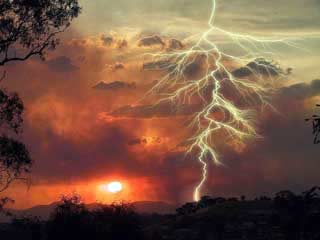 ‘When Thunder Roars, Go Indoors’ ‘When Thunder Roars, Go Indoors’
By Jane Lemon Mott
When Ben Franklin invented the lightning rod, he stated that he
felt that the greatest benefit it had to mankind was not the
saving of property and lives but the reduction in anxiety that
people felt when an electrical storm approached.
Unfortunately, we have gone past that feeling of relative
safety to a state where many of us fail to recognize any need for
caution. According to NOAA News Online (story 2676), lightning has
already killed at least 27 people in the United States this year
and injured over 300.
Fourteen of those deaths have occurred since July 15. Although
there is an average of 66 lightning deaths a year in the United
States (tornadoes claim an average of 65 lives per year), the
deaths for the second half of July 2006 are more than double the
July averages of previous years.
It’s time we took lightning seriously again. For those who
spend a good amount of time outdoors the risks are the greatest.
This year’s July fatalities include teenagers playing soccer,
golfers, campers, and people mowing lawns on riding mowers. The
fact that you are reading this paper is a strong indicator that
you spend a significant amount of time out of doors.
Do you recognize the danger that comes with an electrical
storm, and do you do what is necessary to stay safe?
I can honestly say that over the years I have paid little
attention to the danger of lightning. The news stories of
lightning-strike victims usually get little attention.
With one or two killed or injured at a time, it’s easy not to
get a true perspective of the threat lightning poses, and although
you may read reports of the deaths, there is very little written
of those who sustain debilitating injuries from lightning. These
injuries often have lifelong effects on a victim’s physical and
mental well being.
Common sense should tell us about now that we need to remind
ourselves that lightning is a dangerous force of nature and that
we need to take action to protect ourselves when a potential
electrical storm approaches. The following recommendations for
lightning safety are adapted from the Web site
www.lightningsafety.noaa.gov .
Read them, remember them , pass them on to family and friends,
but most important, follow them when storm clouds are headed your
way!
- Watch for developing thunderstorms: Towering cumulus clouds
are often the first sign of a developing thunderstorm.
- When to seek shelter: If you can hear thunder, you are
within striking distance. Seek safe shelter immediately
- What is safe shelter? A substantial building that is
enclosed; you are not safe in any building that is open to the
outside such as carports, covered patios, picnic shelters,
baseball dugouts, or any tent structure. A hard-top metal
vehicle is also a safe shelter, but you need to avoid contact
with any metal object in the vehicle.
- The 30-30 rule: When you see lightning, count the seconds
until you hear the thunder. If that time is 30 seconds or less,
you are within striking distance. Wait at least 30 minutes after
you hear the last thunder before leaving safe shelter.
- Outdoor activities: Minimize the risk of being struck. Any
outdoor group activity must be stopped at the first sound of
thunder. Leaders of outdoor events should have a written plan
that must be enforced.
- Things to avoid indoors: Stay off corded phone, computers,
and any equipment that put you in direct contact with
electricity or plumbing. Buy ground-fault protectors for key
equipment. Follow the 30-30 rule.
- Helping a lightning strike victim: If a person is struck by
lightning, call 911 immediately! The most common effects of a
strike are cardiac arrest and irregularities, burns, and nerve
damage. Know CPR. Most victims survive a lightning strike with
proper treatment.
- Summary: Lightning is dangerous. NOAA’s advice?
- "When Thunder Roars, Go Indoors.
|
 September
2006
September
2006 September
2006
September
2006